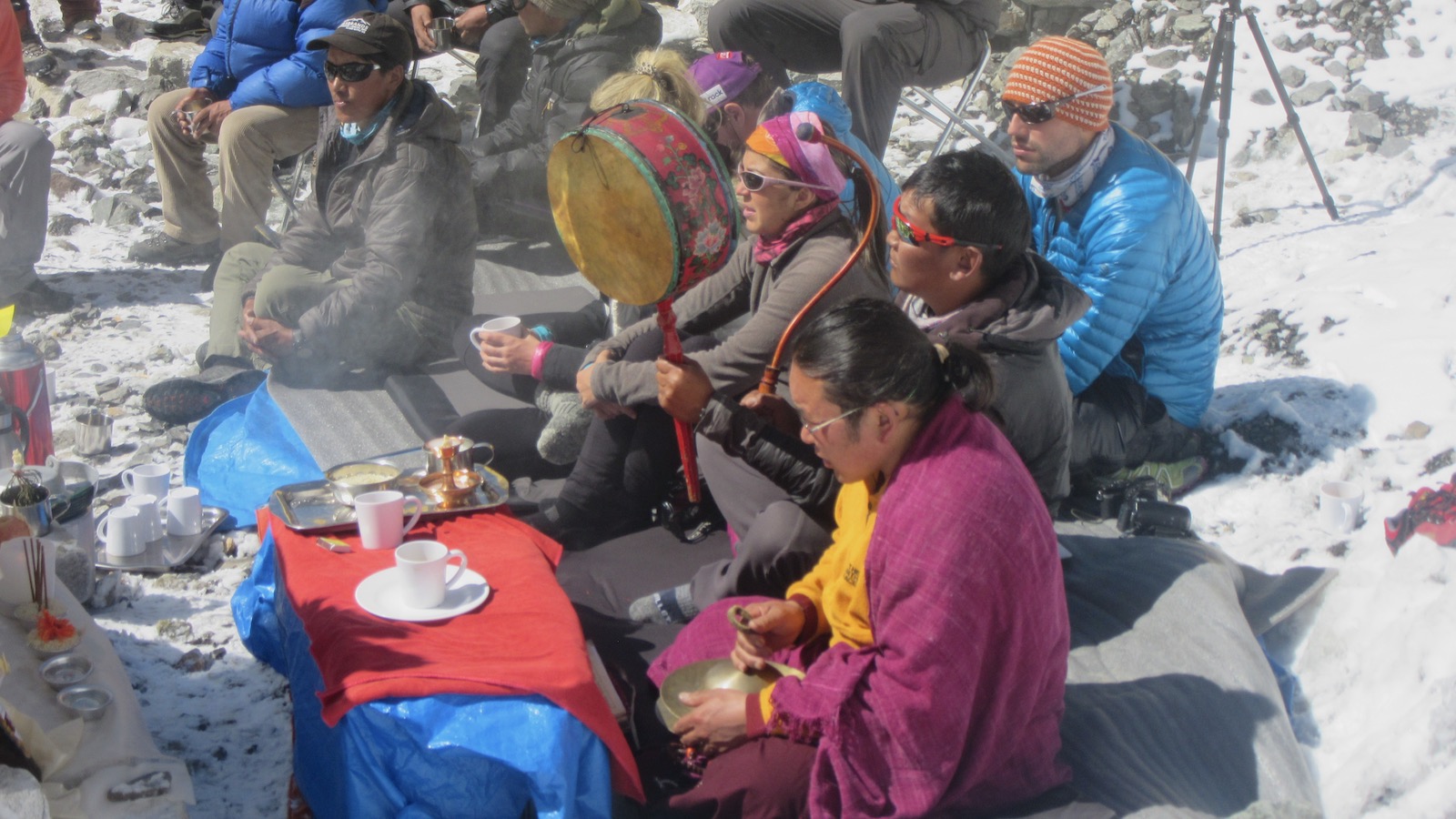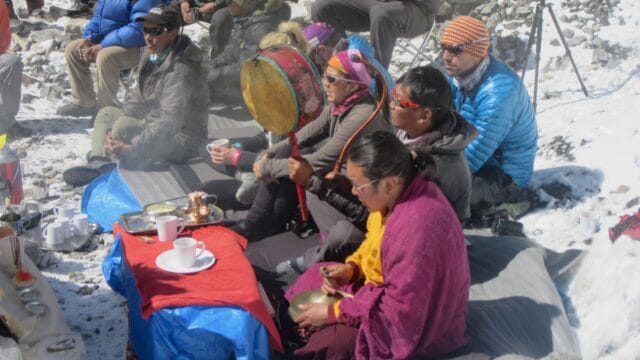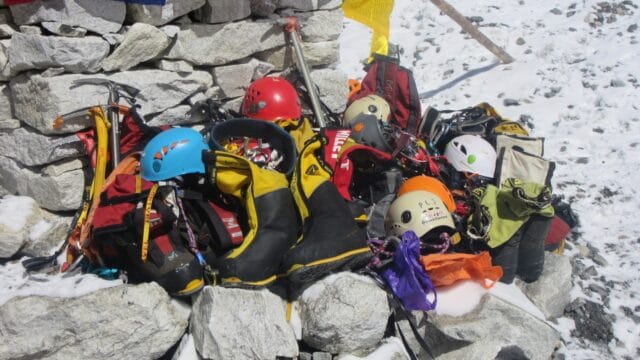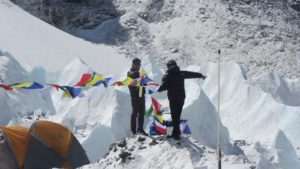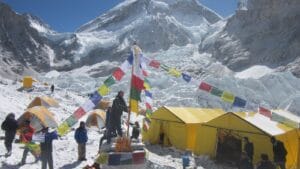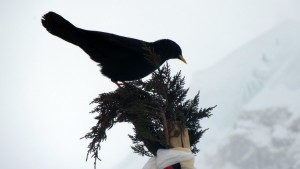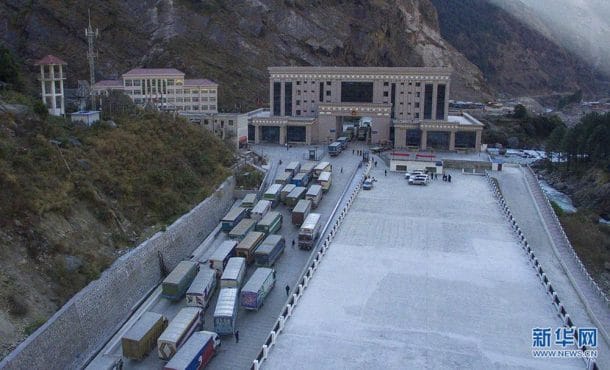Before climbing begins, the Sherpas perform a puja ceremony. Usually, a Buddhist Lama treks in from a nearby monastery the night before. If at a big camp like Everest, he will perform several ceremonies during the same day. If the camp is too far away from a monastery, for example, on K2, then one of the Sherpas will perform it. Today, our fictional team will have their ceremony.
Virtual Everest 2020 – Support the Climbing Sherpas is a joint project of Alan Arnette and several global guide companies. Our objective is to entertain Everest fans during the Coronavirus spring closure and raise money to help the Climbing Sherpas who were not working this spring. While there will be accurate historical references, this series is a work of fiction. Names, characters, and incidents either were products of my imagination or were used fictitiously. Any resemblance to actual events or locales or persons, living or dead, is entirely coincidental. Please join us by making a donation using the links below plus by adding your Everest experiences in the comment section.
Puja at Base Camp
“Tomorrow, we will have our Puja. Bring your harness, crampons, ice axes and anything sharp to the ceremony.” Guide announced over a dinner of lamb, rice and tomato soup. Old Man stood up. Everyone looked at him, not sure what to expect. “Last year, at our Puja, I was changed. I was skeptical of these types of ceremonies, here and back home, but seeing the seriousness the Climbing Sherpas took the Puja caused me to look at them differently. With even more respect, with more admiration. So, if you don’t want to participate, that’s OK. It’s really for the Sherpas, but they welcome us to join.”
Breakfast came early as the cooks and Sherpas were anxious to start the ceremony. The Sherpas had spent the previous day collecting large, flattish stones to build the rock altar. It was back-breaking work, but they smiled and laughed as they worked. The stone Stupa is used primarily to hold the flag pole and to hold several revered pictures, including one of the Dali Lama. Blankets were laid out for the climbers to sit on during the long ceremony.
Ceremonies mark life. Many come with the birth of a child, the union of a couple, or upon death. Today was a ceremony to climb a mountain, but as with all ceremonies, it meant much more to those involved.
The Puja is a traditional ceremony lead by a Lama where the Mountain Gods are asked permission for the climbers to climb, forgiveness for the damage caused by the climbing and safety for all involved. All the Sherpas, climbers, cooks – anyone associated with the climb is invited to participate or observe.
The morning was warm and bright, much different from the past few days. Over breakfast, the team smelled smoldering juniper boughs that enveloped the camp. As it came time for the beginning of the ceremony, the Sherpas moved with an air of excitement and purpose. The team moved to the highest point in the camp where a large rock altar was built.
The couple left their tents and walked towards the altar. “Oh, I forgot my harness,” Boyfriend said. “Yeah, I forgot my ice axe, will you get it for me,” Girlfriend added. They were looking forward to the Puja, never having attended one. They had spent hours on the trek talking with Dawa. He explained some of his Buddhist beliefs and traditions. How he respected other people’s beliefs and never tried to change them, also never tried to convert someone to Buddhism. The couple agreed later that the time with Dawa opened their eyes to a different culture, and the way they practiced their life.
“Got ’em.” Boyfriend said, catching up with his mate. The climbing harnesses were to be blessed for safety and the ice axes and crampons for forgiveness for the holes the climbers would put in the mountain snow and ice. Snorer and the two new climbers who had taken a different trek to EBC brought pictures of their families and placed them on the altar. They planned to leave them on the summit.
The Lama sat to the far left of the altar. He sat on three blankets on the ground and had another wrapped around his legs. He was Mingma Dorge Sherpa, a Lama from Pangyboche, and had been conducting pujas for years. To his right sat several Sherpa, who assisted with the Puja. The Lama had a pair of small cymbals that he clanged throughout the ceremony as did a Sherpa with a small drum. The constant accompaniment of music perfectly matched the chanting.
The Lama began the Puja by reading from 300-year-old Tibetan prayer books. The Sherpas joined in, all chanting in unison. The climbers sat in rows behind the Lama and Sherpas, while everyone else mingled around. The ceremony had a serious tone, but it was not terminally so. Camera shutters and video cams were in full action trying to capture the moment.
Dutch sat quietly, his socked feet on top of his thighs, his hands placed in his lap. He closed his eyes and let the smell of the juniper and the sound of the chanting soak into his essence. He had never felt this way. All of his senses were alive, stimulated, and at the same time very much at peace.
Sherpas walked the area serving everyone milk tea, a sweet concoction of sugar, milk, and tea. The Lama and his Sherpas drank milk tea and chang, a potent rice wine. The Lama, with help from the team cooks, prepared the food, including baking and creating food sculptures, the night before. Trays of cookies, breads and other sweets sat by the altar.
The prayers went on for two hours. Once completed, the Sherpas jumped into action. Two took the eight-foot-long pine tree trunk, the puja pole, and lifted it atop the altar. They dropped it in a crack at the altar top. Prayer flags had already been attached to the top. Then other Sherpas took the end of the string of flags and went to multiple points around the camp so that each string fluttered over the tents. She watched in amazement at their precision designed so that every tent had a flag over it. They were careful to treat the flags with reverence. Once the pole was up a black Himalayan Chuff promptly flew over and perched on top – a sign of good luck.
The energy increased with more tea and chang filling everyone’s cups. Without coordination but at the same time, the Lama and Sherpas by his side, stood up as another series of chants began. Three series of low growls, “akalu,” which meant “victory to the gods,” in other words, the Gods had granted their wishes for permission, forgiveness, and safety. At the end of the third growl, everyone threw rice in the air three times, an auspicious number of times, and began cheering.
As the enthusiasm picked up, even more, Dawa grabbed a bowl of tsampa, roasted barley powder. He went from person to person – climbers, cooks, Guide, Sherpas, anyone around and lathered their cheeks, so they now looked white, symbolizing a white beard that comes with old age.
Then another Sherpa came by with a bottle of Jonnie Walker whisky. Each person held just the bottle cap, while the Sherpa, Mingma this time, filled it up. He paused long with her, his Charge, careful She did the ceremony correctly. As instructed, Snorer put one fingertip into the cap and threw the drops over his shoulder three times; then he drank the rest. When offered, Loner shook his head no. The Sherpa smiled and moved on.
With the formal part of the Puja complete, the Sherpas started serving more drinks, beer, whisky, soda, water along with the pastry the Lama had cooked the night before. The Sherpas began to “Sherpa Dance,” a form of line dancing but with precise footwork. Old Man tried to join in but had trouble keeping up.
The couple stepped away from the group to observe. “You see how everyone is coming together, Girlfriend said, “This Puja was about the Sherpas, but they included everyone. They shared food, embraced one another in the line dance, smiled so easily, and laughed sincerely. Yet, there is a seriousness and a conviction to their efforts that leaves the ceremony behind.”
I agree, Boyfriend said, adding, “These Sherpas are affirming their dedication to one another on yet another dangerous climb of the highest mountain on earth. In recent years, more Sherpas have died on Everest than non-Sherpas. They know this all too well. While this ceremony was certainly to honor and make a request of the mountain Gods, it was also to commit themselves to one another, to be there when needed, to support and be supported when the time came.”
Standing nearby, Guide joined the couple, “The Puja is a very important part of an expedition to me. It’s a Buddhist blessing, and for me, it’s always important to respect the culture of the place I am visiting. At first, I did it mainly for the locals. Now I feel I really want to do it for myself. I hope this will provide us with good luck! We will see!”
Climb On!
Alan
Memories are Everything
Climbing Sherpa Support
Who, how much, and how often you donate is a personal decision. Maybe you climbed with one of the guides, or plan to one day. Perhaps you have followed them for years and want to support their Climbing Sherpa team, or maybe you support by geography – Nepali, American, Austrian, British, New Zealand. It’s up to you and will be much appreciated.
My sincere appreciation to those companies who accepted my invitation to join Virtual Everest 2020 – Support the Climbing Sherpas
- Alpine Ascents International: Click to Donate to Alpine Ascents’ Climbing Sherpas
- Adventure Consultants: Click to Donate to Adventure Consultant’s Climbing Sherpas
- Alpenglow Expeditions: Click to Donate to Alpenglow Expedition’s Climbing Sherpas
- Furtenbach Adventures: Click to Donate to Furtenbach Adventure’s Climbing Sherpas
- International Mountain Guides: Click to Donate to IMG’s Climbing Sherpas
- Jagged Globe: Click to Donate to Jagged Globe’s Climbing Sherpas
- Madison Mountaineering: Click to Donate to Madison Mountaineering’s Climbing Sherpas
- Mountain Professionals: Click to Donate to Mountain Professional’s Sherpas
For an overview of the Virtual Everest 2020 – Support the Climbing Sherpas, please visit this post.
Previous Virtual Everest 2020 posts:
- Virtual Everest 2020 – Support the Climbing Sherpas
- Virtual Everest 2020: Leaving Home
- Virtual Everest 2020: Flying at the Summit of Everest
- Virtual Everest 2020: Weekend Video Update April 5
- Virtual Everest 2020: Hello Kathmandu!
- Virtual Everest 2020: Kathmandu
- Virtual Everest 2020: Exploring Kathmandu
- Virtual Everest 2020: The First Team Dinner
- Virtual Everest 2020: Lukla Drama
- Virtual Everest 2020: The Trek Begins
- Virtual Everest 2020: Weekend Video Update April 12- Guy Cotter Interview
- Virtual Everest 2020: Everest View
- Virtual Everest 2020: Blessing in the Khumbu
- Virtual Everest 2020: Leaving the Trees
- Virtual Everest 2020: Remembering
- Virtual Everest 2020: The Trekker’s Summit
- Virtual Everest 2020: April 18, Honoring the Fallen
- Virtual Everest 2020: Weekend Video Update April 19- Gordon Janow Interview
- Virtual Everest 2020: Settling into Base Camp

